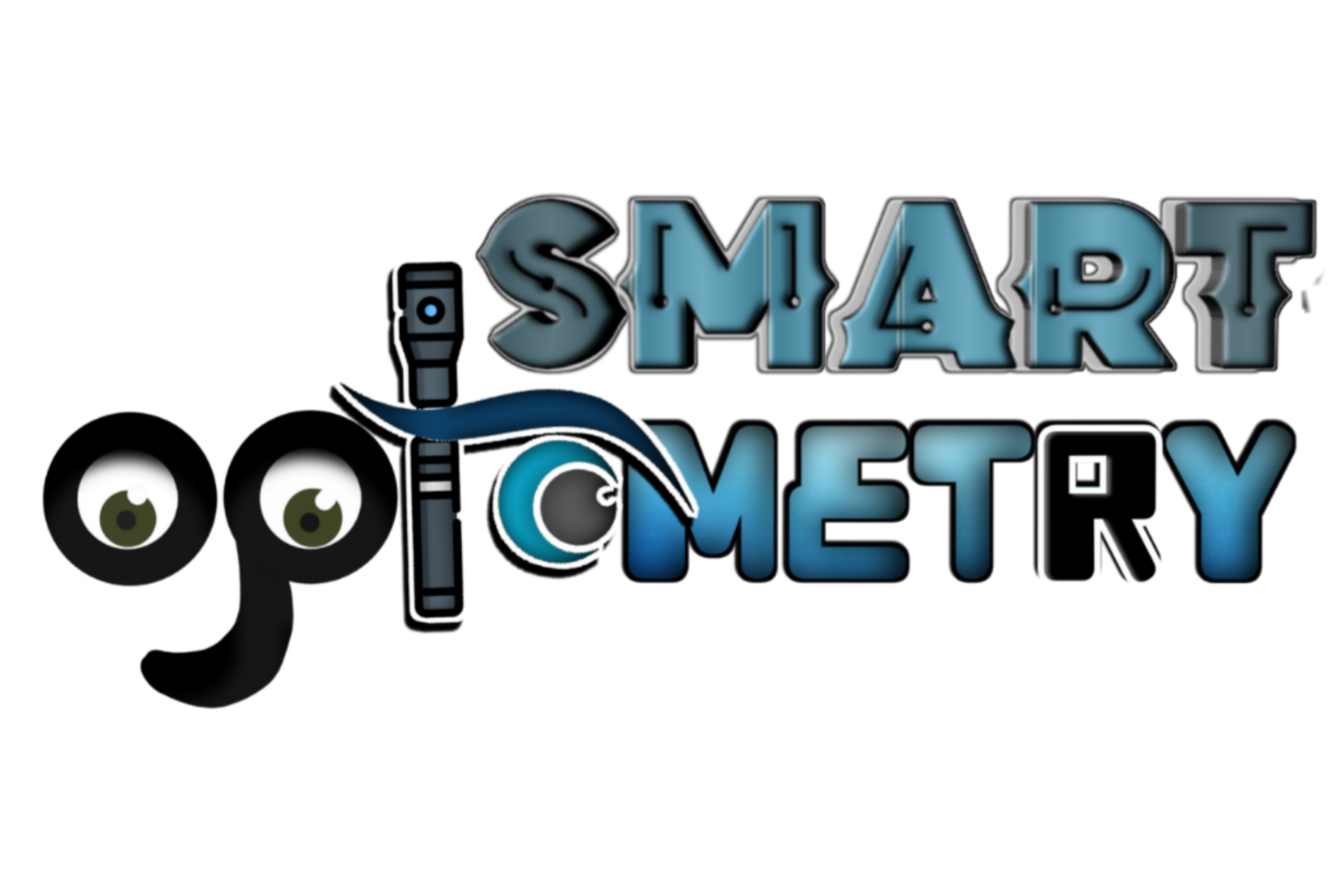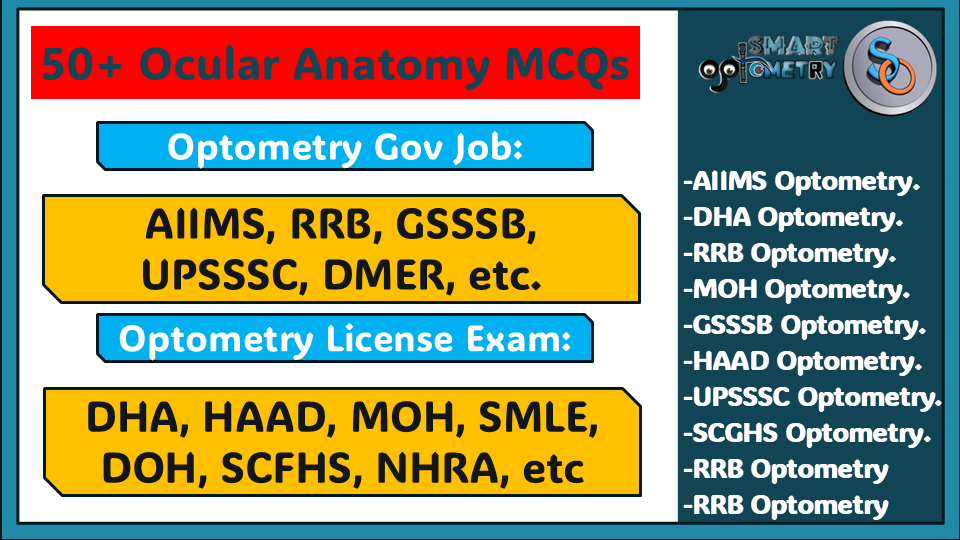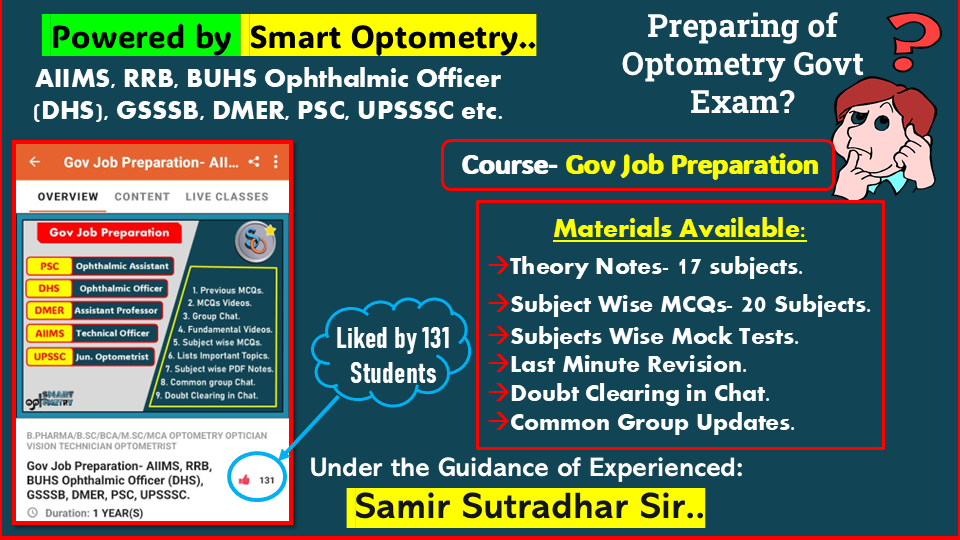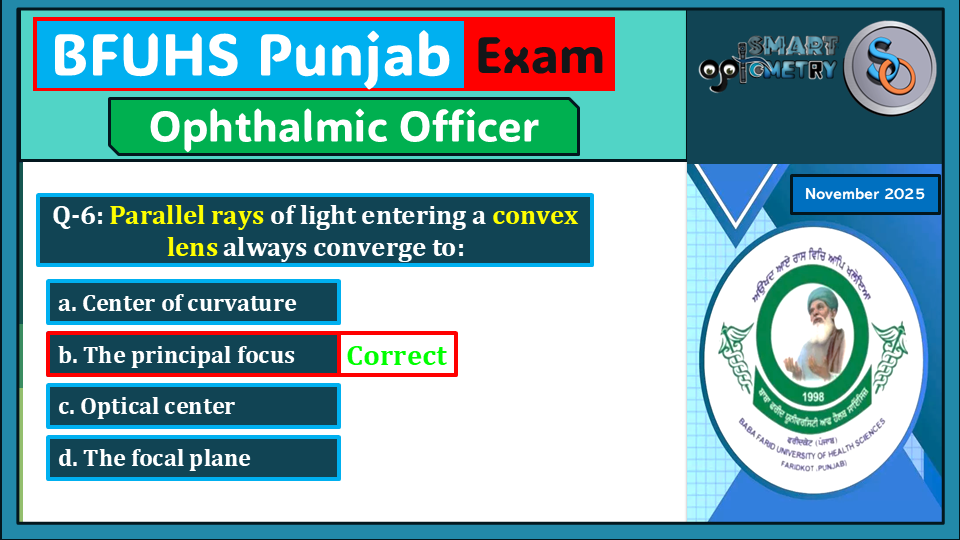Topic 1: The Orbit
Q-1: The bony orbit is formed by how many bones? (AIIMS optometry mcqs)
a. 5 Bones
b. 6 Bones
c. 7 Bones
d. 8 Bones
.
.
Q-2: Which is the thinnest and most fragile wall of the orbit? (DHA optometry mcqs)
a. Superior wall
b. Inferior wall
c. Medial wall
d. Lateral wall
Struggling with your optometry government job preparation? Let Samir Sir, the founder of Smart Optometry, guide you to success. Enroll in our “Gov Job Preparation” course, and we’ll provide the roadmap. Your dream job at AIIMS, RRB, or DHS is within reach!
.
.
Q-3: Which of the following structures pass through the optic canal? (RRB optometry mcqs)
a. Oculomotor and vein
b. Optic nerve and artery
c. Trochlear and artery
d. Optic nerve and vein
.
.
Q-4: What fraction of the total orbital volume does the eyeball occupy? (HAAD optometry mcqs)
a. One-third
b. One-fourth
c. One-fifth
d. One-half
Preparing for your Optometry License Exam? Our “MCQs in Optometry” course is specifically designed to help you succeed. With 1000+ previous year Prometric MCQs and guidance from Samir Sir, you’ll be ready for exams like DHA, HAAD, MOH, and SMLE.
.
.
Topic 2: Parts & Ocular Structure
Q-5: What is the average anteroposterior diameter of a normal adult eyeball? (GSSSB optometry mcqs)
a. 22 mm
b. 23 mm
c. 24 mm
d. 25 mm
.
.
Q-6: Which axis of the eye joins the point of fixation, the nodal point, and the fovea? (MOH optometry mcqs)
a. Visual axis
b. Optical axis
c. Fixation axis
d. Pupillary axis
Unlock your potential with our “Gov Job Preparation” course. Gain access to a massive library of 5000+ subject-wise MCQs, 1000+ previous year questions, detailed notes, and video lectures. Everything you need for exams like GSSSB, PSC, and DMER is in one place.
.
.
Q-7: A positive angle kappa, where the visual axis is nasal to the pupillary axis, results in what clinical appearance? (UPSSSC optometry mcqs)
a. Pseudo-outward deviation
b. Pseudo-inward deviation
c. Upward deviation
d. Downward deviation
.
.
Q-8: What is the approximate depth of the anterior chamber in a normal adult? (SMLE optometry mcqs)
a. 2.0 mm
b. 3.0 mm
c. 4.0 mm
d. 5.0 mm
Confidence comes from practice. Our “MCQs in Optometry” course gives you an edge with over 6000 MCQs, including subject-wise and previous year Prometric questions. Master every topic and walk into your license exam fully prepared.
.
.
Topic 3: The Cornea
Q-9: What is the approximate net refractive power of the cornea? (DMER optometry mcqs)
a. +20 D
b. +43 D
c. +58 D
d. -5 D
.
.
Q-10: Which layer of the cornea, once destroyed, is incapable of regeneration and heals by forming a scar? (NHRA optometry mcqs)
a. Epithelium
b. Bowman’s layer
c. Stroma
d. Descemet’s membrane
Prepare for a full year of opportunities! Our “Gov Job Preparation” course gives you 12 months of access to top-quality materials and support. Cover all major exams like UPSSSC and Ophthalmic Officer without buying multiple courses. It’s the smartest investment for your career.
.
.
Q-11: Which corneal layer is responsible for maintaining corneal transparency by actively pumping water out of the stroma? (Ophthalmic Assistant optometry mcqs)
a. Epithelium
b. Stroma
c. Descemet’s membrane
d. Endothelium
Navigate your license exam preparation with an expert by your side. Join the “MCQs in Optometry” course and get direct guidance from Samir Sir, founder of Smart Optometry. We take responsibility for your preparation, so you can focus on learning.
.
.
Q-12: The corneal endothelium has a limited capacity for regeneration. Corneal decompensation and edema typically occur when the cell count drops below what threshold?
a. 2000 cells/mm²
b. 1500 cells/mm²
c. 1000 cells/mm²
d. 500 cells/mm²
Don’t study alone! Our “Gov Job Preparation” course includes group chat and live support to clear all your doubts instantly. With guidance from Samir Sir and a community of fellow aspirants, you’ll stay motivated and on track.
Click “Show more” to see the answer and explanation.
Answer: d. 500 cells/mm²
A healthy young adult has an endothelial cell count of around 2400–3000 cells/mm². Due to a large functional reserve, corneal decompensation does not usually occur until the cell count falls below 500 cells/mm².
.
.
Topic 4: Limbus & Sclera
Q-13: Which surgical incision for cataract surgery is considered the safest because it is least likely to damage the trabecular meshwork or cause Descemet’s stripping? (KMLTTB optometry mcqs)
a. Scleral incision
b. Mid-limbal incision
c. Anterior limbal incision
d. Clear corneal incision
.
.
Q-14: Where is the sclera thinnest? (Refractionist mcqs)
a. At the posterior pole
b. At the limbus
c. At the equator
d. At muscle insertion points
Why settle for less? The “MCQs in Optometry” course is your all-in-one solution. For a full year, you get access to thousands of MCQs, theory notes, videos, group chat, and live support. It’s the only resource you’ll need to pass your exam.
.
.
Q-15: What is the lamina cribrosa? (DOH optometry mcqs)
a. Innermost sclera layer
b. Episcleral blood network
c. Sieve-like sclera portion
d. Sclera-cornea junction
Click “Show more” to see the answer and explanation.
Answer: c. Sieve-like sclera portion
The lamina cribrosa is a mesh-like structure in the posterior scleral foramen that allows the axons of the retinal ganglion cells to exit the eyeball and form the optic nerve. It is a common site of injury in glaucoma.
.
.
Q-16: What is the primary reason for the sclera’s opacity, in contrast to the cornea’s transparency? (Technical officer ophthalmology mcqs)
a. High water content
b. Irregular collagen fibrils
c. Presence of blood vessels
d. Absence of keratocytes
Ready to secure your government job in optometry? The “Gov Job Preparation” course is your final destination. With a proven success strategy, expert mentorship, and over 6000 MCQs, we make your preparation seamless and effective. Click the link to begin your journey!
Click “Show more” to see the answer and explanation.
Answer: b. Irregular collagen fibrils
Unlike the uniformly arranged, small-diameter collagen fibrils in the cornea, the scleral collagen fibrils have a wide variation in diameter and are irregularly spaced. This irregular arrangement causes them to scatter light and appear opaque.
.
.
Topic 5: The Uveal Tract
Q-17: Which muscle of the iris is responsible for constricting the pupil (miosis), and what is its nerve supply? (AIIMS optometry mcqs)
a. Sphincter pupillae (Parasympathetic)
b. Dilator pupillae (Sympathetic)
c. Sphincter pupillae (Sympathetic)
d. Dilator pupillae (Parasympathetic)
Click “Show more” to see the answer and explanation.
Answer: a. Sphincter pupillae (Parasympathetic)
The sphincter pupillae is a circular muscle in the pupillary part of the iris that constricts the pupil. It is innervated by parasympathetic fibres from the oculomotor nerve (CN III).
.
.
Q-18: What is the primary action of the ciliary muscle? (DHA optometry mcqs)
a. Increase aqueous production
b. Flatten the lens
c. Accommodation for near
d. Drain aqueous humor
Your optometry license is just a step away. Enroll in our “MCQs in Optometry” course and let us handle the rest. With expert guidance and a comprehensive question bank, success is guaranteed. Click here to start your journey to becoming a licensed optometrist!
Click “Show more” to see the answer and explanation.
Answer: c. Accommodation for near
Contraction of the ciliary muscle releases tension on the zonular fibres (suspensory ligaments). This allows the elastic lens to assume a more rounded shape, increasing its refractive power for focusing on near objects.
.
.
Q-19: Which layer of the choroid consists of a rich capillary network responsible for nourishing the outer layers of the retina? (RRB optometry mcqs)
a. Suprachoroidal lamina
b. Stroma layers
c. Choriocapillaris
d. Bruch’s membrane
Click “Show more” to see the answer and explanation.
Answer: c. Choriocapillaris
The choriocapillaris is a dense, single-layered network of wide-lumened capillaries. It provides nourishment to the retinal pigment epithelium and the outer retinal layers, including the photoreceptors.
.
.
Q-20: The venous drainage from the entire choroid, iris, and ciliary body is primarily collected by which vessels? (HAAD optometry mcqs)
a. Central retinal vein
b. Anterior ciliary veins
c. Venae verticosae
d. Ophthalmic veins
.
.
Topic 6: The Crystalline Lens
Q-21: Which surface of the crystalline lens is more convex? (GSSSB optometry mcqs)
a. Anterior surface
b. Posterior surface
c. Equatorial surface
d. Both surfaces are equal
.
.
Q-22: Which of the following statements about the lens capsule is TRUE? (MOH optometry mcqs )
a. Thinnest at anterior pole
b. Thickest basement membrane
c. Contains elastic tissue
d. It is a cellular layer
Click “Show more” to see the answer and explanation.
Answer: b. Thickest basement membrane
The lens capsule is a non-cellular, transparent membrane composed mainly of type IV collagen. It is the thickest basement membrane in the body and is highly elastic despite lacking true elastic fibres.
.
.
Q-23: Where are new lens fibres continuously formed throughout life? (UPSSSC optometry mcqs)
a. Central anterior epithelium
b. Posterior pole
c. Equatorial anterior epithelium
d. From the lens nucleus
Click “Show more” to see the answer and explanation.
Answer: c. Equatorial anterior epithelium
The cells in the germinative zone at the equatorial region of the anterior lens epithelium are actively dividing and elongating to form new lens fibres. This process continues throughout life and causes the lens to grow.
.
.
Q-24: How does the accommodative power of the lens typically change with age? (SMLE optometry mcqs)
a. It increases
b. It stays constant
c. It decreases
d. It decreases after 60
Click “Show more” to see the answer and explanation.
Answer: c. It decreases
The lens gradually loses its elasticity with age, leading to a progressive decline in its ability to accommodate. This power decreases from a high of 14-16 dioptres in infancy to only 1-2 dioptres by age 50, a condition known as presbyopia.
.
.
Topic 7: The Vitreous Body
Q-25: The vitreous humour is an inert, transparent gel composed of approximately what? (DMER optometry mcqs)
a. 90% water, 10% proteins
b. 99% proteins, 1% water
c. 50% water, 50% collagen
d. 99% water, collagen, and acid
Click “Show more” to see the answer and explanation.
Answer: d. 99% water, collagen, and acid
The vitreous is the largest and simplest connective tissue in the body, consisting of about 99% water. The remaining 1% is a complex network of type II collagen fibrils and hyaluronic acid molecules, which give it a gel-like consistency.
.
.
Q-26: What is the hyaloid canal (Cloquet’s canal)? (SCFHS optometry mcqs)
a. Aqueous drainage channel
b. Space between vitreous, retina
c. Remnant of fetal artery
d. Vitreous-ciliary attachment
Click “Show more” to see the answer and explanation.
Answer: c. Remnant of fetal artery
Cloquet’s canal is a clear, central channel within the vitreous that marks the former path of the hyaloid artery. This artery supplied the developing lens during fetal life and subsequently regressed.
.
.
Q-27: The anterior hyaloid membrane is attached to the posterior lens capsule in a circular ring by which structure? (Ophthalmic Assistant optometry mcqs)
a. Hyaloidocapsular ligament
b. Ora serrata
c. Zonular fibres
d. Retrolental ligament
.
.
Q-28: What are the resident cells of the vitreous, primarily found in the cortical vitreous, which are thought to synthesize collagen and hyaluronic acid? (NHRA optometry mcqs)
a. Fibroblasts
b. Hyalocytes
c. Astrocytes
d. Macrophages
Click “Show more” to see the answer and explanation.
Answer: b. Hyalocytes
Hyalocytes are the intrinsic cells of the vitreous, located in the cortical layer near the retinal surface. These cells are believed to be responsible for the metabolism of the vitreous, including the synthesis of its structural components.
.
.
Topic 8: The Retina
Q-29: Which specialized area of the retina provides the sharpest, most detailed central vision? (Refractionist mcqs)
a. Fovea centralis
b. Optic disc
c. Ora serrata
d. Peripheral retina
Click “Show more” to see the answer and explanation.
Answer: a. Fovea centralis
The fovea centralis is a small depression in the center of the macula that contains the highest concentration of cone photoreceptors. This anatomical specialization is responsible for high-acuity vision used for reading and driving.
.
.
Q-30: Which statement correctly describes the distribution of photoreceptors in the retina? (KMLTTB optometry mcqs)
a. Rods most at fovea
b. Cones evenly distributed
c. Rods absent at fovea
d. Both absent at disc
Click “Show more” to see the answer and explanation.
Answer: c. Rods absent at fovea
The fovea contains a “rod-free zone” to maximize visual acuity, with cones being densely packed. Rods are responsible for night and peripheral vision and are most numerous in a ring-shaped zone surrounding the macula.
.
.
Q-31: Which retinal layer forms the outer blood-retinal barrier, controlling the passage of substances from the choroid to the retina? (Technical officer ophthalmology mcqs)
a. Retinal pigment epithelium
b. Inner nuclear layer
c. Ganglion cell layer
d. Nerve fibre layer
Click “Show more” to see the answer and explanation.
Answer: a. Retinal pigment epithelium
The RPE cells are connected by tight junctions (zonulae occludens), which form the outer blood-retinal barrier. This barrier is crucial for maintaining the specific biochemical environment required for photoreceptor function.
.
.
Q-32: The inner six layers of the retina receive their primary blood supply from which vessel? (DOH optometry mcqs)
a. Choriocapillaris
b. Central retinal artery
c. Long posterior arteries
d. Vortex veins
Click “Show more” to see the answer and explanation.
Answer: b. Central retinal artery
The retina has a dual blood supply. The outer four layers are nourished by the choriocapillaris, while the inner six layers are supplied by the central retinal artery and its branches, which are end-arteries.
.
.
Topic 9: The Visual Pathway
Q-33: The optic nerve is divided into four parts. Which part is the longest? (AIIMS optometry mcqs)
a. Intraocular part (1mm)
b. Intraorbital part (30mm)
c. Intracanalicular part (6-9mm)
d. Intracranial part (10mm)
Click “Show more” to see the answer and explanation.
Answer: b. Intraorbital part (30mm)
The intraorbital portion of the optic nerve, which extends from the back of the eyeball to the optic canal, is the longest segment at approximately 30 mm. Its length provides slack for eye movements.
.
.
Q-34: What is the characteristic arrangement of nerve fibre decussation (crossing) at the optic chiasma? (DHA optometry mcqs)
a. All fibres cross
b. Nasal fibres cross
c. Temporal fibres cross
d. No fibres cross
Click “Show more” to see the answer and explanation.
Answer: b. Nasal fibres cross
At the optic chiasma, fibres from the nasal (medial) half of each retina decussate to the contralateral optic tract. Fibres from the temporal (lateral) half of each retina do not cross and continue into the ipsilateral optic tract.
.
.
Q-35: In the lateral geniculate body (LGB), which layers receive synaptic input from the contralateral (opposite) eye? (RRB optometry mcqs)
a. Layers 1, 4, and 6
b. Layers 2, 3, and 5
c. Layers 1, 3, and 5
d. Layers 2, 4, and 6
Click “Show more” to see the answer and explanation.
Answer: a. Layers 1, 4, and 6
The LGB has six distinct layers. Fibres from the contralateral eye (carrying information from the temporal visual field) synapse in layers 1, 4, and 6. Fibres from the ipsilateral eye synapse in layers 2, 3, and 5.
.
.
Q-36: Where is the primary visual cortex (Area 17 or V1), the main destination for visual information, located? (HAAD optometry mcqs)
a. Frontal lobe
b. Temporal lobe
c. Occipital lobe
d. Parietal lobe
.
.
Topic 10: Extraocular Muscles (EOM)
Q-37: The four rectus muscles (superior, inferior, medial, lateral) originate from what common fibrous structure at the orbital apex? (GSSSB optometry mcqs)
a. Annulus of Zinn
b. Trochlea
c. Orbital septum
d. Periorbita
.
.
Q-38: The scleral insertion points of the four rectus muscles are not equidistant from the limbus, instead forming an imaginary line known as what? (MOH optometry mcqs )
a. Circle of Zinn
b. Spiral of Tillaux
c. Equator of the eye
d. Annulus of Zinn
.
.
Q-39: Which cranial nerve is responsible for innervating the lateral rectus muscle, which abducts the eye? (UPSSSC optometry mcqs)
a. Third cranial nerve
b. Fourth cranial nerve
c. Sixth cranial nerve
d. Fifth cranial nerve
Click “Show more” to see the answer and explanation.
Answer: c. Sixth cranial nerve
The lateral rectus muscle is innervated solely by the abducent nerve (CN VI). Its function is to abduct the eye (turn it outward). A common mnemonic is LR6SO4 (Lateral Rectus by 6, Superior Oblique by 4, the rest by 3).
.
.
Q-40: Which extraocular muscle is the longest and thinnest, with its action being redirected by a pulley-like structure called the trochlea? (SMLE optometry mcqs)
a. Inferior oblique
b. Superior rectus
c. Medial rectus
d. Superior oblique
Click “Show more” to see the answer and explanation.
Answer: d. Superior oblique
The superior oblique is the longest (total length ~60 mm) and thinnest of the extraocular muscles. Its tendon passes through the trochlea, which acts as a physiological origin, redirecting the muscle’s pull to cause intorsion, depression, and abduction.
.
.
Topic 11: The Conjunctiva
Q-41: Which cells, found abundantly in the conjunctival epithelium, are responsible for secreting the mucin layer of the tear film? (DMER optometry mcqs)
a. Melanocytes
b. Lymphocytes
c. Goblet cells
d. Epithelial basal cells
Click “Show more” to see the answer and explanation.
Answer: c. Goblet cells
Goblet cells are specialized, mucin-secreting glands located within the conjunctival epithelium. The mucin they produce is essential for lubricating the ocular surface and ensuring the stability of the tear film.
.
.
Q-42: The adenoid (lymphoid) layer of the conjunctiva is not well-developed at birth. What is the clinical significance of this? (SCFHS optometry mcqs)
a. More prone to allergies
b. No follicular reaction
c. Cannot produce mucus
d. More transparent
Click “Show more” to see the answer and explanation.
Answer: b. No follicular reaction
The adenoid layer, which contains lymphoid tissue that forms follicles in response to inflammation, typically develops 2-3 months after birth. Therefore, newborns and young infants do not exhibit a follicular response in conjunctivitis.
.
.
Q-43: The lymphatic vessels from the lateral side of the conjunctiva drain primarily into which lymph nodes? (Ophthalmic Assistant optometry mcqs)
a. Submandibular
b. Submental
c. Deep cervical
d. Preauricular
Click “Show more” to see the answer and explanation.
Answer: d. Preauricular
The conjunctival lymphatics are divided into two drainage pathways. The lymphatics from the lateral portion drain into the preauricular lymph nodes (in front of the ear), while those from the medial portion drain into the submandibular lymph nodes.
.
.
Q-44: Which part of the conjunctiva is a continuous circular cul-de-sac that allows the eyeball to move freely and is deepest in the superotemporal region? (NHRA optometry mcqs)
a. Palpebral conjunctiva
b. Bulbar conjunctiva
c. Limbal conjunctiva
d. Conjunctival fornix
Click “Show more” to see the answer and explanation.
Answer: d. Conjunctival fornix
The conjunctival fornix is the junctional region where the palpebral conjunctiva (lining the eyelid) reflects to become the bulbar conjunctiva (covering the eyeball). This loose, folded cul-de-sac provides the necessary slack for extensive eye movements.
.
.
Topic 12: The Lacrimal Apparatus
Q-45: The main lacrimal gland is divided into two parts by the aponeurosis of which muscle? (Refractionist mcqs)
a. Superior rectus
b. Lateral rectus
c. Levator palpebrae superioris
d. Orbicularis oculi
Click “Show more” to see the answer and explanation.
Answer: c. Levator palpebrae superioris
The main lacrimal gland is divided into a larger, superior orbital part and a smaller, inferior palpebral part by the lateral horn of the aponeurosis of the levator palpebrae superioris muscle.
.
.
Q-46: Which layer of the tear film is secreted by the Meibomian, Zeis, and Moll glands and functions to prevent tear evaporation? (KMLTTB optometry mcqs)
a. Aqueous layer
b. Mucin layer
c. Lipid layer
d. Glycocalyx layer
Click “Show more” to see the answer and explanation.
Answer: c. Lipid layer
The outermost lipid layer of the tear film is an oily secretion produced by the Meibomian, Zeis, and Moll glands. This layer stabilizes the tear film and prevents rapid evaporation of the underlying aqueous layer.
.
.
Q-47: The nasolacrimal duct, the final part of the lacrimal drainage system, opens into which part of the nasal cavity? (Technical officer ophthalmology mcqs)
a. Superior meatus
b. Middle meatus
c. Inferior meatus
d. Sphenoethmoidal recess
Click “Show more” to see the answer and explanation.
Answer: c. Inferior meatus
The nasolacrimal duct travels from the lacrimal sac downwards, backwards, and laterally to open into the inferior meatus of the nose, under the inferior turbinate. This is where tears drain from the eye.
.
.
Q-48: What is the name of the mucosal fold at the lower end of the nasolacrimal duct that prevents air from entering the lacrimal sac when blowing the nose? (DOH optometry mcqs)
a. Valve of Rosenmuller
b. Valve of Hasner
c. Sinus of Maier
d. Lacrimal papilla
Click “Show more” to see the answer and explanation.
Answer: b. Valve of Hasner
The valve of Hasner is a mucosal flap at the nasal opening of the nasolacrimal duct. It acts as a one-way valve, preventing the retrograde flow of air and nasal secretions into the lacrimal drainage system.
.
.
Topic 13: The Eyelids
Q-49: Which structure within the eyelid is a dense fibrous plate that provides its structural integrity and shape?
a. Orbital septum
b. Tarsal plate
c. Orbicularis oculi
d. Palpebral conjunctiva
.
.
Q-50: The eyelid margin is divided into anterior and posterior portions by a landmark known as the:
a. Punctum
b. Lid fold
c. Grey line
d. Mucocutaneous junction
Click “Show more” to see the answer and explanation.
Answer: c. Grey line
The grey line is an important surgical landmark on the intermarginal strip of the eyelid margin. It represents the most anterior part of the orbicularis muscle and divides the lid into an anterior and a posterior lamella.
.
.
Q-51: Which glands are modified sebaceous glands located within the tarsal plates, with their openings on the posterior lid margin, responsible for secreting the lipid layer of the tear film?
a. Glands of Moll
b. Glands of Zeis
c. Glands of Krause
d. Meibomian glands
Click “Show more” to see the answer and explanation.
Answer: d. Meibomian glands
The Meibomian glands (or tarsal glands) are large sebaceous glands embedded vertically within the tarsal plates. They secrete sebum, the oily component that forms the superficial layer of the tear film, preventing its evaporation.
.
.
Q-52: Which two muscles are primarily responsible for opening and closing the eyelids, and what are their respective innervations?
a. Orbicularis oculi (CN III) and Levator palpebrae superioris (CN VII)
b. Orbicularis oculi (CN VII) and Levator palpebrae superioris (CN III)
c. Frontalis (CN III) and Corrugator (CN VII)
d. Müller’s muscle (CN VII) and Levator palpebrae superioris (Sympathetic)
Click “Show more” to see the answer and explanation.
Answer: b. Orbicularis oculi (CN VII) and Levator palpebrae superioris (CN III)
Eyelid closure (blinking) is performed by the orbicularis oculi muscle, which is innervated by the facial nerve (CN VII). Eyelid opening is primarily performed by the levator palpebrae superioris muscle, innervated by the oculomotor nerve (CN III).
.
.
- Check Our Courses: Ophthalmic Instrumentation, Clinical Refraction, Contact Lens, Binocular Vision, Dispensing Optics, MCQs in Optometry
- Download our App “Optometry Notes & MCQs” from Google Play Store.




